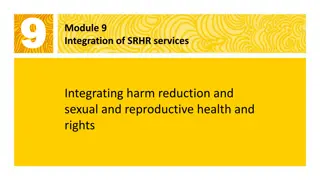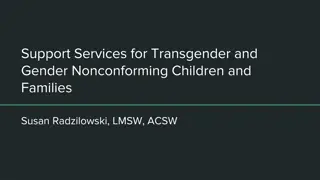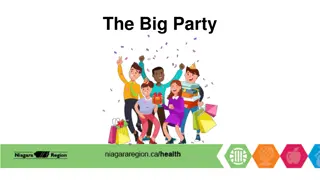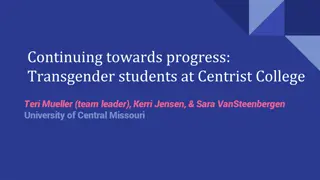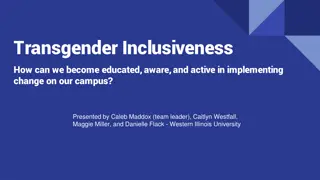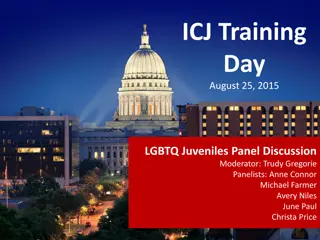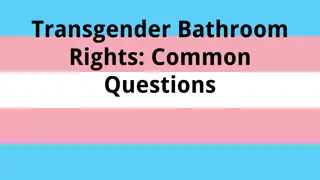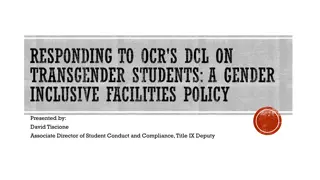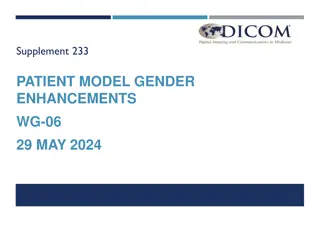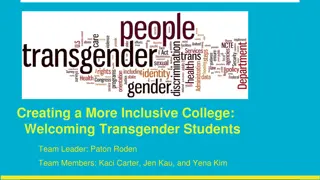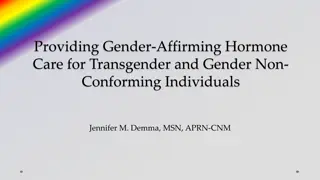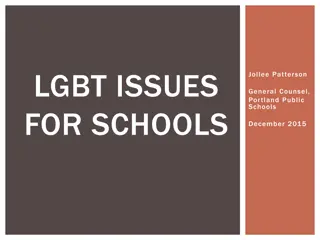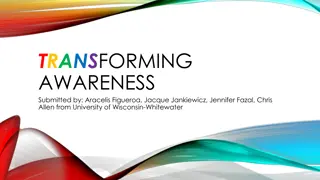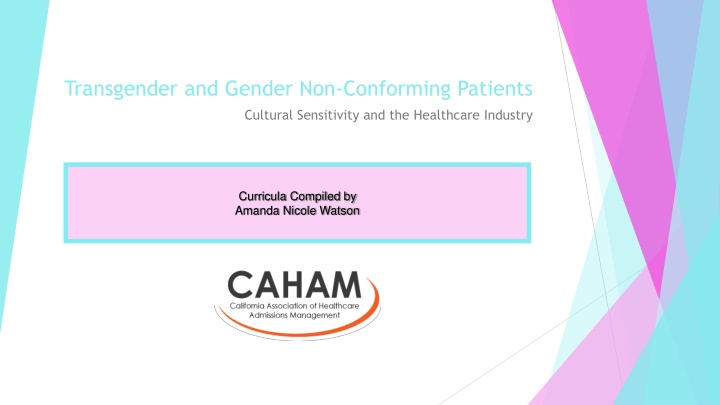
Transgender and Gender Non-Conforming Patient Care
Explore the importance of cultural sensitivity in healthcare for transgender and gender non-conforming individuals, covering gender expectations, working with transgender persons, and advocating for inclusion. Gain insights from Amanda Nicole Watson, a seasoned healthcare professional with a passion for transgender rights advocacy and community support.
Download Presentation

Please find below an Image/Link to download the presentation.
The content on the website is provided AS IS for your information and personal use only. It may not be sold, licensed, or shared on other websites without obtaining consent from the author. If you encounter any issues during the download, it is possible that the publisher has removed the file from their server.
You are allowed to download the files provided on this website for personal or commercial use, subject to the condition that they are used lawfully. All files are the property of their respective owners.
The content on the website is provided AS IS for your information and personal use only. It may not be sold, licensed, or shared on other websites without obtaining consent from the author.
E N D
Presentation Transcript
Transgender and Gender Non-Conforming Patients Cultural Sensitivity and the Healthcare Industry Curricula Compiled by Amanda Nicole Watson
Outline Introduction Why is this topic important? Gender Expectations and Roles Gender Awareness Sex, Gender, & Sexuality. What Is Transgender? Why Are People Transgender? Working With Transgender Persons Being An Ally For LGBT People Challenge Stereotypes Encourage Inclusion Prepare Yourself For A Journey Recommendations for Registration Data And Statistics
Amanda Nicole Watson Received highest level of achievements in Scouting Eagle Scout Order of the Arrow U.S. Navy Veteran, Hospital Corps Successfully advocated for transgender rights in Baltimore City and San Diego City Received San Diego Pride s Community Service award in 2004 Received Gloria Steinem Communication award in 2004 Received Award of Recognition from City Commissioner Nicole Ramirez Murray Has participated in multiple panels and speaking engagements on topics surrounding transgender and gender non-conforming communities 30 years experience in healthcare Licensed Psychiatric Technician Utilization Review Patient Access Registration Financial Counseling Quality Assurance Management Patient Financial Service Serves on the Advisory board for Gender Programs and Services at California State University Fresno Former, Board of Directors of Trans-E-Motion
Employees 8,100+ 2 facilities 1,117 licensed beds total Community Regional Medical Center Level I trauma and burn center Skilled Nursing / Sub-Acute Behavioral Health 909 licensed beds total including behavioral health, sub-acute, skilled nursing and rehabilitation 43,124 admissions per year 5,687 births per year 111,769 ED visits per year Clovis Community Medical Center 208 licensed beds 14,609 admissions per year 5,183 births per year 60,564 ED visits per year Regional Cancer Center (under construction)
Why is this topic pertinent to you? Transgender and gender non-confirming people suffer significant healthcare barriers in accessing care Provide positive patient satisfaction and healthcare experience Increasing number of transgender persons presenting as a result of expanded healthcare and transgender visibility Requirement for Meaningful Use (MU) 3 - Requires the ability to collect sexual orientation and gender identity Health Resources and Services Administration UDS - Requires health centers to report outcomes that include information about each patient s Sexual Orientation and Gender Identity Healthy People 2020 - Improve access to comprehensive, quality health care services. Improve the health, safety, and well-being of lesbian, gay, bisexual, and transgender (LGBT) individuals. American Medical Association (AMA) 2017 House of Delegates inform and educate the medical community and the public on the medical spectrum of gender identity. Potential for lawsuits July of 2015 the Office for Civil Rights and a New York City Medical Center were sued Transfemale presented as female was roomed in a double occupancy room with a male occupant Settlement involved, the Medical Center has two years to educate and comply with the new standard
Gender Expectations What are some of the characteristics we expect from a normal man? What are some of the characteristics we expect from a normal woman? Example: mannerisms, clothing, career, marriage, reproduction ). What is society s view when one doesn t meet these expectations? What rewards are there for people who meet our society s expectations of their gender? What punishments are there for people who don t?
Gender Awareness Awareness of ones gender is usually developed around 18 months It continues though 2 years of age Fully developed by no later than age 5. Gender identity is usually formed by the age of 3. It is not uncommon for children to state by age 5 that they should have been opposite gender.
Sex, Gender, And Sexuality Everyone has a sex, a gender identity, a gender expression, and a sexual orientation. How all these factors are related, or what causes any given individual to have the particular mix of characteristics that defines his or her identity, is not yet known and may never be known. In everyday language as well as in the law, the terms gender and sex are often used interchangeably. However, these are two completely different concepts and it is important to distinguish between the two terms. Every person s sex, gender, and sexuality is very personal, complex, and unique to them.
SEX Refers to biological or anatomical sex The presence of specific reproductive and sexual organs Both internal and external organs The chromosomal profile (XY or XX) that distinguishes the male sex and the female sex of an individual. While many people believe that all humans are born clearly male or female, this is not true. At least 1 of every 1,500 children is born with a mixture of male and female sexual characteristics that makes it difficult, even for an expert, to label them male or female.
Gender Identity & Expression GENDER is a social construct that refers to the sense of maleness or femaleness or otherness experienced at personal, social, and cultural levels. A persons' gender includes: Identity. How one views themselves in relation to how society defines a man or a woman. Expression. The way one presents themselves to others. Attribution. What someone assumes about your gender when they look at you. An individual may fall anywhere along these spectra. Some people identify entirely within one gender while others may feel that their gender is more fluid and combines aspects of both male and female.
Sexual Orientation Refers to whom one is physically, emotionally and romantically attracted to forming intimate relationships. This also varies greatly from person to person, and may change at any time during the course of life. Transgender people are no more or less likely to be gay, lesbian, bisexual, pansexual or heterosexual than any other specific population group. The ratio is comparatively similar to cisgender people. Oftentimes, cisgender people misperceive transgender people as gay or lesbian because of Physical characteristics The manner in which a transgender person expresses themselves Because they do not understand that transgender people identify their sexual orientation based on their internal perception of their gender and not their anatomical sex.
Gender Identity (How One Sees Themselves) Feminine Identity Masculine Identity Non-Binary / Gender fluid
Gender Expression (How One Presents) Feminine Androgynous Masculine
Sexual Orientation (Romantic/Sexual Desire) Feminine Androgynous Masculine
What Is Transgender? Transgender people are individuals of any age or sex Whose appearance, personal characteristics, or behaviors differ from stereotypes about how men and women are supposed to be. Transgender is a large umbrella term that embraces numerous people who share the common experience of perceiving or expressing their gender differently from cultural norms and expectations.
Some Common Terms Trans / Transgender - Transman / Transwoman Transsexual FTM (Female to Male)/MTF (Male to Female) AMAB (Assigned Male at Birth) AFAB (Assigned Female at Birth) Transmasculine / Transfeminine Enby (Non-Binary) a gender identity which does not fit into the male / female binary Genderqueer (a person who does not subscribe to conventional gender distinctions but identifies with neither, both, or a combination of male and female genders) Androgynous (indeterminate presentation) Genderfluid (no fixed gender) Bigender (both genders) Agender (no gender) Intersex (formerly hermaphrodite) Crossdresser (formerly Transvestite) Dead name using a person s birth name Cisgender a person who was born in the body with which they identify
Transsexuals (Medical Transition) Transsexuals are considered to be the smallest single population within the larger transgender world Transsexuals are people who were born anatomically male or female and raised in the matching gender role, but who have a deep internal sense of actually being the opposite sex and gender from the one in which they were raised. Transsexuals often describe their feelings as being a woman trapped in a man s body, or a man trapped in a woman s body. Transsexuals are generally thought to have a condition called gender dysphoria (also called gender identity disorder).
MTF Or FTM? Those who are born physically male but are emotionally and psychologically female are properly referred to as male to female or MTF's. Also known as AMAB (Assigned Male at Birth) Those who are born female but are emotionally and psychologically male are properly referred to as female to male or FTM's. Also known as AFAB (Assigned Female at Birth) There is some disagreement as to whether gender dysphoria is a physical condition, a psychological condition or both. More common medical thought is that this is a medical condition and not a mental condition Scientists now believe that the transgender phenomenon occurs when the developing fetus is in the womb and a chemical imbalance occurs in their development. Initially at conception the hormonal bathing sends a message that tells the fetus how to develop anatomically Later the hormonal bathing to promote brain development sends a message that contains the opposite hormones for body development
Transition (Medical Transition) The primary way transsexuals usually differ from other transgender people is that, as a majority, they seek to modify their bodies through hormones, sex reassignment surgery, or a combination of both. This process, which may take several months or many years, and which is extremely expensive, is called transition, where transsexuals will make major life changes in order to bring their physical appearance in line with their gender identity. Some of those changes include changing their name and gender designation on legal documents such as birth certificates, driver's licenses and social security records. However it is achieved, the ultimate goal of transition is to enable the transsexual to live completely as the gender with which they identify.
Non-Medical Transition (formerly Transgenderist) By far the single largest population within the transgender world These individuals too experience a sense of disconnection between their physical body and their internal sense of gender (maleness, femaleness, or otherness.). What typically distinguishes this population from other transgender people is that they do not usually seek to modify their bodies through hormones or gender confirmation surgery. Instead, they assert a right to identify their gender beyond their anatomical sex, and use other resources or expression tools, like clothing, name change, and mannerisms, to express themselves. Gender is, in many ways, a social construct A set of expectations, prohibitions, permissions, rewards, and punishments enforced by ethnic and social cultures, which varies from culture to culture.
Intersexed (Formerly Hermaphrodite) Individuals born with a mixture of male and female sexual organs, and some individuals whose chromosomal profiles are in conflict with their sexual anatomy, are known as intersexed. This replaces the outdated term hermaphrodite, which is now considered to be a pejorative similar to calling a gay man a faggot or a lesbian a dyke. Some intersexed people are born with genitals that look like most girls or boys genitals, but may have internal reproductive organs usually associated with the other sex. Others have bodies that do not spontaneously go through puberty or go through pubertal changes usually associated with the opposite sex, or experience some of the pubertal changes of both sexes.
Intersexed Parents concerned about their infant s health and well-being are often frightened by this variation. Although genital ambiguity does not in itself represent a health problem, parents often fear that their children will be adversely affected by being different. Around the late 1950s, it became widespread practice to subject intersexed children to surgeries and hormone treatments intended to ensure that the child is viewed as clearly female or clearly male. These procedures are not medically necessary; instead, they are designed to make the child s genitals look more normal. Often intersexed people are able to adapt somewhat to their assigned gender, but sometimes this does not work out the way the doctors believe it will. Sometimes the person s gender turns out to be the opposite of their surgically assigned sex. In other cases, the person always feels in between. In some cases, intersexed people must undergo the same medical treatments as transsexual people and face the same social obstacles and prejudices. The current supported medical practice is to allow the child to develop and make decisions about their body as the mature.
Crossdressers (Previously Known As Transvestites) Crossdressers in general identify as, and are completely comfortable with, their physical gender at birth Will occasionally dress and take on the mannerisms of the opposite gender. Cross-dressing in western culture is less accepted when men do it Example, western culture accepts the idea of a woman wearing pants, but not a man wearing a skirt. Most crossdressers are heterosexual men. The term transvestite is now considered offensive and should not be used because it is associated with negative images of sexual fetishism.
Non-Binary (Enby) Not all transgender people fit neatly into the previous categories. For some, such characterizations of gender and gender identity are more constraining than liberating. Non-binary people may or may not identify as one or the other in a binary gender system (i.e. Either/or, male/female) Many times they will assume a mixture of male and female dress and characteristics, combining elements of both. Have an androgynous (both masculine and feminine) gender identity Have an identity between male and female Have a neutral or unrecognized gender identity Have multiple gender identities, such as bigender or pangender. Have a gender identity which varies over time, known as genderfluid. Have a culturally specific gender identity which exists only within their or their ancestor's culture
Why Are People Transgender? Although social scientists and the medical and mental health establishments have advanced a number of theories and suppositions, the plain truth is: We don t know why some people are transgender any more than we know why other people are cisgender. Before concluding that there is something fundamentally wrong with transgender individuals simply because they are a minority of the larger human population Minority status has long been used by the prevailing majority of the time to marginalize and disempower people. Minority status, which is fundamentally an issue of difference, is not a valid argument to support stigmatization or discrimination.
Working With Transgender Persons Avoid terms that are offensive Avoid Gendered Language Always use terms that are respectful General principles: Use the pronoun of gender expression not origin Deal with the identity that s presented Ask for the persons pronouns if you are not sure It is better to ask than to potentially offend Its possible to speak without using labels
Being An Ally For LGBT People In today s world, LGBT issues are being discussed more than ever before In the media, in community programs, in schools, churches, offices, in the streets, and in people s homes. These discussions are often emotionally charged as this can be a threatening topic for many people, and clear information is often difficult to find. Being an ally is important, but it is challenging as well as exciting. This list is not exhaustive, but provides some starting points.
Talking To/About Someone Who is Trans Pronouns Feminine: She/Her/Hers/Herself -She walked into class at 9:00 am, and turned in her homework. Masculine: He/Him/His/Himself -He walked into class at 9:00 am, and turned in his homework. Neutral: They/Them/Theirs/Themself -They walked into class at 9:00 am, and turned in their homework. Neutral: Zie/Hir/Hirs/Hirself -Zie walked into class at 9:00 am, and turned in hir homework. Neutral: Xe/Xem/Xyr/Xemself -Xe walked into class at 9:00 am, and turned in xyr homework.
Talking To/About Someone Who is Trans Avoid Gendered language Think about language that might normally be gendered. If it bothers them, don t use it. Sir Ma am Dude Guys Ladies Gentlemen Miss Misses Mister
The Best Way to Find Out About a Person Ask Pronouns Language Preferences Name Don t assume Which bathroom to direct someone to tell them where both are. Which dress codes (if gendered) tell them both.
Being an AllyUse Language that Promotes Acceptance When you say We hear . Alternative option I don t want to be labelled as Cis I am just normal, you are not or My Identity is the basis for which all other peoples identities should be judged I don t understand this term. Can you explain it to me? Translates to I see you as an equal and look to you to educate me. I read this article (or saw this documentary), your not really a <insert term here>? I know all about people like you! or I know more about you than you do. I saw this information about your community how do you feel about the source? Translates to I accept who you are and look to you as the expert. What is your Birth/legal/real name? I don t care who you are now, I want to know things you did not offer to share. What name do you want me to call you? And does it matter who else is around? Translates to I respect your autonomy. I ve never heard of that pronoun or identity, so I don t think it s real. You re only valid if I understand you. I m not familiar with that term. Can you share what it means to you so I can research it further? Translates to You want to help me and don t want to offend me.
Dont Ever Assume Heterosexuality We tend to assume that everyone we meet is heterosexual even though we know this is not true. Often people hide that they are LGBT until they know it is safe to come out in a given situation. Use neutral language when first working with students/clients/customers until you know for certain what the person prefers (for example, the gender of their significant other). There are many resources, reading lists, and organizations available forinformation. Don t be afraid to ask questions. Doing so can be a valuable process for everyone, regardless of their sexual orientation or gender identity. Integrating LGBT people and issues instead of separating them out as a special topic is an important strategy for conveying and creating respect and acceptance.
Challenge Stereotypes Challenge stereotypes that others may have about LGBT people, as well as other people in our society. Challenge derogatory remarks or jokes made at the expense of any group, and avoid making them yourself. These remarks reinforce stereotypes and make it seem that prejudice is acceptable examine the effect that sexual orientation and gender identity have on people s lives and development. Explore how race, class, ability, gender, etc., Intersect with sexual orientation and how multiple identities shape our lives. Explore your own reactions and feelings about LGBT people and issues, including their causes and if there are any you want to change. Avoid using heterosexist language, such as implying that everyone of one sex or gender dates or marries members of the other sex or gender. Respect how people choose to name themselves. If you don t know how to identify a particular person or group, it is okay to ask as long as you do it respectfully.
Encourage Inclusion Don t expect members of any group that is the target of bias (e.g., LGBT people, Jewish, Muslim, people of color, women, people with disabilities) to be or act as the experts to educate others about their group. Avoid tokenizing or patronizing people different from yourself. Encourage and allow disagreement on issues of gender identity, sexual orientation, and civil rights. These issues are highly charged and contentious for many people. If there isn t some disagreement, it probably means that people are hiding their real views or not participating. Keep discussion and disagreements civil and focused on principles and issues rather than personalities.
You Are Human, Ask For Support Allow yourself to not know everything, to make mistakes, and to occasionally be insensitive. Give yourself time to learn, ask questions, and explore your own ideas and feelings while still setting high expectations for yourself. Extend the same to others. Don t present yourself as an expert unless you truly are one. Ask for support if you are experiencing harassment or other problems related to your raising LGBT issues. You may be labeled as gay, lesbian, bi, or transgender, whether or not you are. Don t isolate yourself. Make sure you are safe, identify your supporters, and use the opportunity to deepen your understanding of the power of homophobia, heterosexism, and transphobia.
Prepare Yourself For A Journey Prepare yourself for a journey of change and growth that will come by exploring sexual orientation, gender identity, heterosexism, and other issues of difference. It can be exciting, painful, and enlightening, and will help you know yourself better. And you ll be improving society in the process! By learning and speaking out as an ally, you will make the world a safer, more affirming place (or everyone. You will change people s lives in ways you ll see and ways you ll never know.
Recommendations for a Hospital System Allow tracking of sex assigned at birth and gender identity within the health information system (HIS) Gender fields should be on medical insurance and/or legal identification. Your gender field or papers should include: M and F because we identify as a binary society. There should be an optional field added to capture gender identity (not limited to the below) Transgender Male (FTM), Transgender Female (MTF) Non-binary Have a field for commonly used name Consider the information printed on the wristband and facesheets Have clearly posted information on the hospitals non-discrimination policy Develop a bed placement policy Pediatric registrations should be handle exactly like adult registrations in relation to gender identity. Have unisex or gender neutral bathrooms available in public areas.
Data And Statistics What data that does exist demonstrates intolerance and hostility Hate crimes statistics, 1-2 murders per month in the United States All the jurisdictions that passed anti-discrimination protections had sufficient evidence of discrimination to merit adopting them Why is there little data available on transgender persons? Rarely are there more than 2 genders listed on data collection instruments including national census Stigma Fear of disclosure Invisibility / Stealth status
Statistics - US Transgender Study 27,715 respondents 15% Unemployment rate among respondents which is three times higher than the rate in the U.S. population 30% of respondents who had a job reported being fired, denied promotion or some other form of mistreatment due to their gender identity 29% live in a poverty state compared 14% in general US population 30% suffered homelessness at some point in their life 33% of respondents in the year prior to completing the survey, who saw a health care provider had at least one negative experience related to being transgender. 23% of respondents reported that they did not seek the health care they needed in the year prior to completing the survey due to fear of being mistreated as a transgender person. 1 in 4 respondents experienced a problem in the past year with their insurance related to being transgender, such as being denied coverage for care related to gender transition or being denied coverage for routine care because they were transgender. 55% of those who sought coverage for transition-related surgery in the past year were denied, and 25% of those who sought coverage for hormones in the past year were denied. One-third (33%) of those who saw a health care provider in the past year reported having at least one negative experience related to being transgender, with higher rates for people of color and people with disabilities. This included being refused treatment, verbally harassed, or physically or sexually assaulted, or having to teach the provider about transgender people in order to get appropriate care. In the past year, 23% of respondents did not see a doctor when they needed to because of fear of being mistreated as a transgender person
Statistics - US Transgender Study 27,715 respondents 40% have attempted suicide at one point in time (10 times the national average) 1 in 10 respondents who were out to their immediate family reported that a family member was violent towards them because they were transgender 1 in 12 respondents who were out to their immediate family were kicked out of the house, and one in ten ran away from home 46% of respondents were verbally harassed in the past year because of being transgender. Nearly 1 in 10 (9%) of the respondents were physically attacked in the past year because of being transgender. Nearly half (47%) of respondents were sexually assaulted at some point in their lifetime 1 in 10 (10%) were sexually assaulted in the past year.
Statistics - US Transgender Study 27,715 respondents 54% experienced some form of intimate partner violence, including acts involving coercive control and physical harm. 24% have experienced severe physical violence by an intimate partner, compared to 18% in the U.S. population. 31% experienced at least one type of mistreatment in the past year in a place of public accommodation Respondents K-12 54% suffer verbal harassment at school, 24% physically attached, 13% sexually assaulted. 77% of those who were out or perceived as transgender at some point between Kindergarten and Grade 12) experienced some form of mistreatment Such as being verbally harassed, prohibited from dressing according to their gender identity, disciplined more harshly, or physically or sexually assaulted because people thought they were transgender 11% of respondents reported that all of their IDs had the name and gender 32% of respondents who showed an identity document that did not match their presentation, was verbally harassed, asked to leave, denied benefits or assaulted.
Resources TransLine - http://project-health.org/transline/ Fenway's Guide to Sexual Orientation and Gender Identity (SO/GI) Data Collection UCSF Center for Excellence in Transgender Healthcare (http://transhealth.ucsf.edu ) Transgender Health Information Project (Canada) (http://transhealth.phsa.ca ) GLMA - Health Professionals Advancing LGBT Equality (http://www.glma.org) WPATH (World Professional Association for Transgender Health) National Center for Transgender Equality (http://www.transequality.org/) Gender Spectrum (https://www.genderspectrum.org) National LGBT Health Education Center (https://www.lgbthealtheducation.org )
Works Cited Grant, J., Mottet, L., & Tanis, J. (2011). Injustice at Every Turn, a Report of the National Transgender Discrimination Survey. The Taskforce. Haas, A., Rogers, P., & Herman, J. (2014, January). Suicide Attempts among Transgender and Gender Non-Conforming Adults. The Williams Institute. Institute of Medicine. The Health of Lesbian, Gay, Bisexual, and Transgender (LGBT) People: Building a Foundation for Better Understanding. Washington, DC: National Academies Press; 2011.




